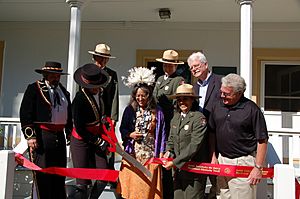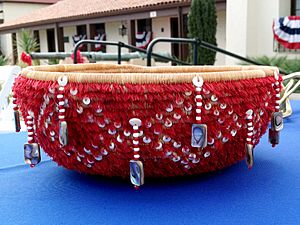Linda Yamane facts for kids
Quick facts for kids
Linda Yamane
|
|
|---|---|

Linda Yamane (center) at a ribbon cutting ceremony in 2010 to celebrate the Grand Opening of the Martinez Adobe with Congressman George Miller
|
Linda Yamane (born in 1949) is a talented artist and historian from the Rumsen Ohlone tribe. She is known for bringing back the Rumsen language, traditional basket-making, and other important Rumsen customs. Many say she has "almost singlehandedly revived" these traditions.
Contents
Linda Yamane's Early Life
Linda Yamane was born in 1949 in San José, California. Her grandmother, Beatrice Barcelona Reno, lived with her family when Linda was young. Beatrice's father was Spanish-Basque, and her mother was Rumsen-Spanish.
By the time Linda's grandmother was an adult, many people thought the Ohlone tribes were gone forever. Her grandmother shared stories from the late 1800s and taught her about using plants for medicine. However, she couldn't teach Linda much about the Rumsen culture itself.
Linda Yamane found out her family history goes back to the 1770s. This includes Josef Manuel Higuera, who was one of the first people to settle in San Jose in 1777. San Jose was California's first Spanish civilian city. Linda also learned about Margarita Maria, a woman from Tucutnut. This was the biggest village of the Rumsen tribe in Carmel Valley in the 1770s. Margarita Maria was given her name when she was baptized by priests in 1773. Linda didn't even hear the names "Rumsen" or "Ohlone" until she was in her 30s.
Linda Yamane's Work
Linda Yamane is a very creative person. She is a singer, painter, and basket maker. She also writes, builds canoes, and is an expert on Rumsen games and their language. She used to work as a graphic designer and illustrator.
Through her deep interest in her family's past, she has learned a lot about Rumsen history and traditions. She works with many museums and cultural places. Her goal is to help save and share knowledge about the Rumsen people and other Ohlone tribes.
For example, in 2005, she helped create an exhibit called Ohlone Portraits: Our Faces, Our Families, Our Stories. This exhibit was at the Crissy Field Center in San Francisco. It showed large portraits from the late 1800s and early 1900s. These portraits came with stories about the people and smaller photos of their family members today.
Linda also creates art for public spaces. She drew a picture of a traditional tule dwelling for signs in the Hillside Natural Area in El Cerrito, California. She also painted a large picture of an old village called Pruistac for the Sanchez Adobe Park. For the past 20 years, she has helped organize Ohlone Day at Henry Cowell Redwoods State Park.
Bringing Back the Rumsen Language
The last elders who spoke Rumsen passed away while living in the missions. This meant that knowledge of the language was lost before the 1900s. Linda Yamane's grandmother knew some Rumsen names and words. She also told many stories from Rumsen tradition, but that was all.
In the mid-1980s, Linda found records from Smithsonian researcher John P. Harrington. He had worked with Isabel Meadows and Manuel Onesimo, two Rumsen elders, in the 1930s. They helped him write down the Rumsen language and details about daily life.
These notes were kept at the Smithsonian and on microfilm at some universities. However, they were written in an old, local Spanish language that Linda couldn't understand. She and Alex Ramirez, Manuel Onesimo's grandson, started working together. They translated all the documents into English. This made many parts of Rumsen life known to English speakers for the first time.
During this research, Linda found a story about a hummingbird and other tales. She decided to write a children's book about creation stories. In 1995, she published When the World Ended: How Hummingbird Got Fire; How People Were Made: Rumsien Ohlone Stories. This book won an Aesop Accolades award in 1995.
Through this translation work, she also met scholar Sandy Lydon. They have been working together since the 1980s. They help each other with their ideas and research about the Rumsen people.
In 1992, Linda attended a "Breath of Life" workshop at University of California, Berkeley. There, she found more words for different types of baskets and tools. The Breath of Life program helps Native American people bring back their old languages.
Linda also found recordings at UC-Berkeley's Hearst Museum. These were old wax-cylinder recordings made by anthropologist Alfred Kroeber in the early 1900s. Elders Viviana Soto and Jacinta Gonzales sang traditional songs and told stories in Rumsen. Linda carefully listened to cassette tapes of these recordings and wrote down what she heard. She started connecting what was on the recordings with what her grandmother had told her. First, she put together stories, and then a large part of the language. These recordings helped her hear how words were pronounced and add more to her Rumsen dictionary.
Because of her hard work, Linda Yamane became the first person to speak the Rumsen language since the last speaker passed away in 1939.
Rumsen Music
Linda Yamane used the songs from Kroeber's recordings for more than just learning words. She focused on putting the songs back together and sharing them with others.
Traditional Basket Making
In Rumsen tradition, a person's handmade items were burned when they passed away. Also, Spanish settlers forced the Rumsen people into missions and destroyed their belongings. Because of this, only about 40 Rumsen baskets were left in the world by the 1980s. The Rumsen people stopped making traditional Olivella baskets when Europeans arrived. The old ways of making them were lost, as no Rumsen basket makers survived.
In the 1970s, Linda learned some basic basket-making skills. Ten years later, she studied an old way of making baskets from women of the Pomo tribe. She visited museums in California, the Smithsonian, the American Museum of Natural History, the Musee du Quai Branly, and the British Museum. All these museums had Rumsen baskets. Linda thought of these baskets as her "teachers." She took notes and photos, counting stitches and coils. She also read notes from researchers who had studied her tribe's basket-making.
Linda follows the methods and ideas from the baskets she saw. She uses the same or similar materials but creates her own designs. By the mid-1990s, she started making her own baskets. She estimates that most baskets take her 2,500 to 3,000 hours to finish.
Finding traditional materials was another challenge. Linda started a garden at home to grow the supplies she needed. She also made agreements with the Bureau of Land Management to gather sedge and other materials from public lands. Even after gathering, materials like willow and sedge can take months or years to dry and get ready for weaving.
Linda Yamane has been a member of the California Indian Basketweavers Association (CIBA) since it started in 1991. She was also a co-editor for CIBA's magazine, Roots and Shoots. Through another group, the Alliance for California Traditional Arts, she taught Carol Bachman. Carol learned both basket weaving and boat making from Linda.
Building Tule Boats
Linda Yamane uses many of the same skills from basket weaving to build tule boats. These boats are called kónon in the Rumsen language. She first learned how to make them in the 1980s. She took photos and notes at an event at Coyote Hills Regional Park in Fremont, California. She didn't make many for nearly 20 years, but since the early 2000s, she has made dozens.
She built one of her first boats for the Monterey History & Art Association's Maritime Museum. They took it out on Monterey Bay. This might have been the first tule boat on the bay in over 150 years. Linda, Carol Bachman, and Cheryl Carter worked together to build this boat.
Olivella Shell Baskets
These special baskets are named after the shiny, bead-like decorations made from the shells of Olivella snails. These snails are found at low tide off the coast of central California. These baskets had not been made for 150 years or more. Making each bead is a lot of work. It involves collecting shells, baking them, then cutting, shaping, and smoothing them. Each bead takes about 10 minutes to make, and only about 3 out of 4 stay whole. A large basket might need thousands of Olivella beads.
To even see these baskets, Linda had to travel to the East Coast of the United States and Europe. No known examples were left in California.
Making Jewelry
Linda Yamane also creates jewelry, especially from abalone shells. Abalone are becoming rare in the ocean, so they are hard to get. Linda was lucky that friends and divers helped her collect many shells. In return, Linda started an abalone shell "bank." This bank helps other Native American artists who want to make traditional art.
Special Art Projects
- 2009: Linda received a grant to make an Ohlone presentation basket. She worked with the Big Sur Land Trust. In 2021, artist Susanne Takehara created a mosaic called Weaving Past & Present. This mosaic, on an apartment building in East Oakland, shows Linda's basket.
- 2010: The Oakland Museum was planning a new exhibit of baskets from California's Native peoples. They realized they had no baskets from the Ohlone tribes of the San Francisco Bay Area. Linda was already a consultant for the museum's basket collection. The museum asked her to make a special ceremonial basket in the Rumsen style. It was shown to the public in 2012. This basket had over 20,000 stitches and 1,200 Olivella beads made by Linda. The thousands of feathers on the basket were chicken feathers dyed red. This is because it is no longer allowed to collect feathers from the acorn woodpecker, which was the traditional source. Linda also gave many live demonstrations of basket weaving at the museum.
Books by Linda Yamane
- When the World Ended: How Hummingbird Got Fire; How People Were Made: Rumsien Ohlone Stories (1995)
- Weaving a California Tradition: A Native American Basketmaker (1996)
- A Gathering of Voices: The Native peoples of the Central California Coast (editor; 2002)
- The Dirt is Red Here: Art and Poetry from Native California (contributor; 2002)


